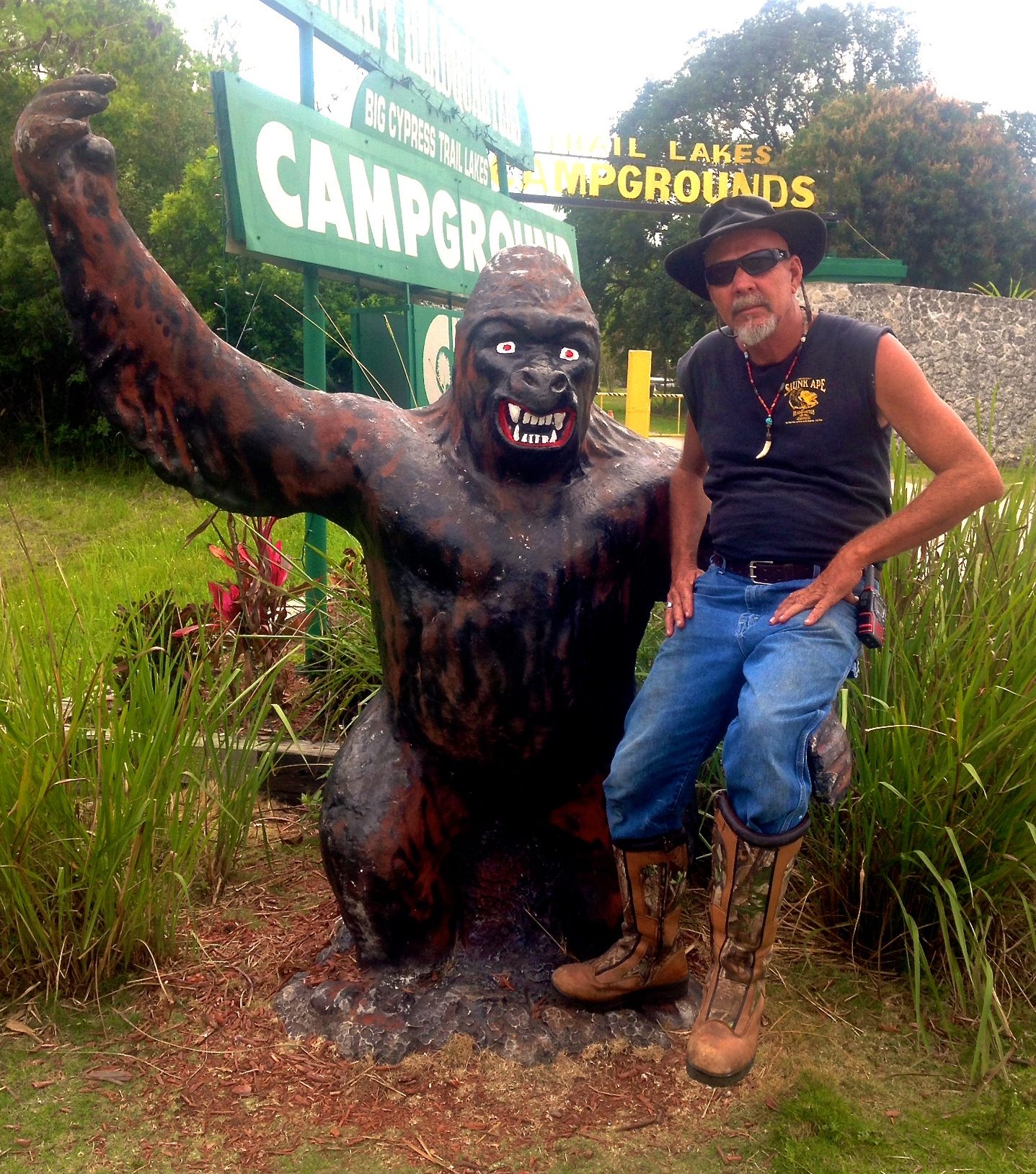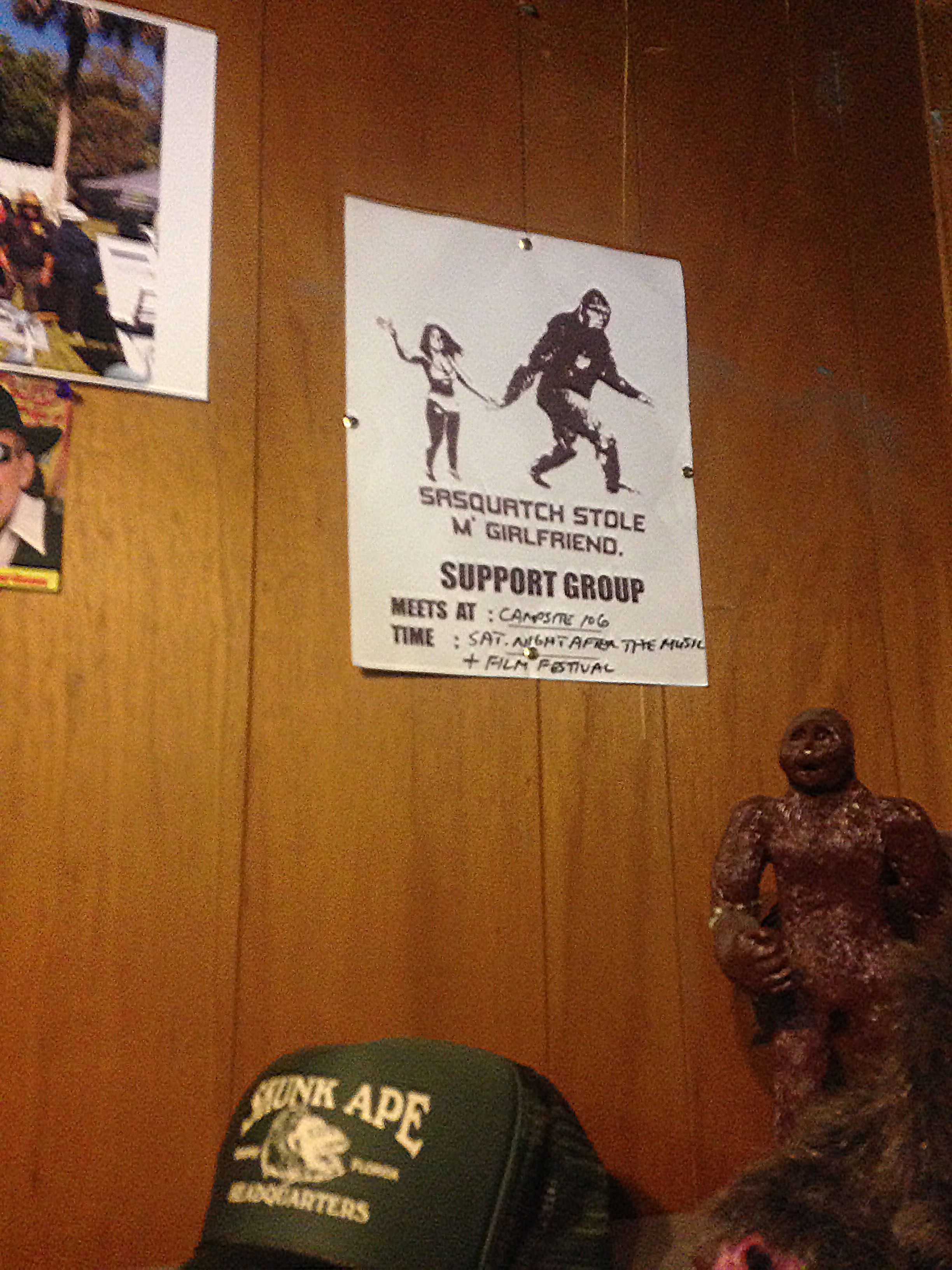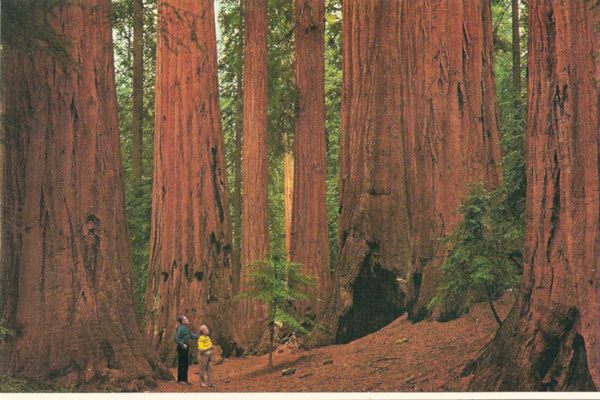The Man Behind Florida’s Favorite Cryptid, The Skunk Ape
 Dave Shealy and the Skunk Ape sculpture. (Photo: Lucia Davis)
Dave Shealy and the Skunk Ape sculpture. (Photo: Lucia Davis)
Unlike the elusive primate that it chronicles, it’s impossible to miss The Skunk Ape Research Headquarters.
Tucked in the middle of Florida’s Everglades, there’s no easy way to get there—one road in, one road out. You’ll have been driving for almost two hours when suddenly, it emerges from the swampscape. There are signs, of course, bright vintage green and gigantic, but the undeniable evidence that you’re in the right place is the six-foot tall statue of an open-armed King Kong cousin—or, as it’s called in these parts, a Skunk Ape.

An illustration from Everglades Skunk Ape Research Field Guide by David Shealy. (Photo: Courtesy www.skunkape.info)
Virtually unknown outside of the Everglades, the Skunk Ape is allegedly a large, bipedal mammal that lives exclusively in south Florida’s tropical wetlands. Legend has it that males of the species can stand more than six and a half feet tall and tip the scales at 450 pounds. Even at that size, it’s smaller than your average Sasquatch, which can supposedly grow up to 10 feet tall and weigh more than 1,000 pounds.
Like its relative, it’s a cryptid—an animal whose existence has been suggested but has not been discovered or documented by the mainstream scientific community. The term applies to living creatures considered to be extinct, such as Kenya’s Muhuru bay monster; wild animals inhabiting places drastically far from their natural habitat, like Phantom Kangaroos; and beasts that appear in myths or are reported. The Skunk Ape falls into the final category, joined by the likes of The Jersey Devil, Nessie and the Chupacabra. Because of its reliance on anecdotal evidence rather than scientific proof, cryptozoology is not recognized as a branch of zoology nor as a scientific discipline. As such, devotees ardently search for hard evidence of existence, like DNA samples or a body.
The Skunk Ape is no different and the mission of the Research Headquarters is to find proof.
 Inside the research center. (Photo: Lucia Davis)
Inside the research center. (Photo: Lucia Davis)
The man behind the monster is Dave Shealy, who has dedicated his life to studying this evasive, probably imaginary creature. An Everglades native, Shealy grew up hearing about Skunk Apes as a child, as some creature hiding in the swamps. Though President Truman formally dedicated Everglades National Park in 1947, the original 2.2 million acre tract was a fraction of the total land area now protected by the government. It wasn’t until 1978 that the majority of the region was officially declared a wilderness area. Born in 1963 in what’s now Big Cypress National Preserve, Shealy is among the last generation of locals not from the Seminole tribe. As such, the area had a much higher residential population during Shealy’s childhood. More people meant more Skunk Ape sightings. “It was kind of the topic of conversation at the time,” Shealy says.
Shealy was just 10 years old the first time he laid eyes on a Skunk Ape. “There was a rule around the house: if my brother, Jack, and I could kill a deer before school, we didn’t have to go to class,” Shealy tells me. One misty morning, hunting for hooky in the high grass, Jack spotted movement up ahead. “He lifted me up to where I could see over the grass and, maybe a 100 yards away, there was an animal—looked like a man covered with hair walking across the field in front of us,” he recalled. Excited and terrified, the boys ran home to tell their parents.
In the 40 years since that cardinal encounter, Shealy has become the leading, if not the only, Skunk Ape expert. In addition to establishing the headquarters, he’s written a field guide; made countless television appearances; been interviewed by dozens of publications, from The Smithsonian to The Naples Daily News; and has seen the creature on three additional occasions since that first boyhood sighting. From Gatorland veterinarians to park rangers, if there’s something strange in the neighborhood, Shealy’s on speed dial.


Shealy with a plaster cast of a Skunk Ape footprint and an image of a Skunk Ape footprint. (Photo: Courtesy www.skunkape.info)
This is why, four years ago, a pair of terrified tourists wandered into the Research Headquarters—a ranger sent them.
“There was an incident on the Turner River Road, which was reported to the National Parks Service,” Shealy prefaced before recounting a series of events part “creature feature,” part Thelma and Louise. Two vacationing European women were photographing bromeliads when they heard something rustling in the nearby bushes. They turned towards the sound and were confronted by a male Skunk Ape, standing just feet from their rented convertible. Not only was he agitated, but he appeared to be “ready to mate,” Shealy recalls with a chuckle. A leering Bigfoot looking for romance is hilarious in theory, but proved terrifying in person.
“They ran around the car, jumped in over the windshield, and took off down to the park service to tell them what happened. By the time they got here, more than an hour had passed but they were still shaking,” Shealy says. “They were very afraid.”
Though colorful, this was a very atypical Skunk Ape encounter. “It’s the only occasion I’ve seen where anybody was frightened by one,” Shealy says. “There’s never been a reported incident of a Skunk Ape ever attacking a person,” he adds, “but there’s an old legend here in the ‘glades that if you go in the woods and hurt one of them, you’ll never get out of the woods alive. And there are many people unaccounted for, missing, in the Everglades.”
 Vintage sign in the research center’s reptile zoo. (Photo: Lucia Davis)
Vintage sign in the research center’s reptile zoo. (Photo: Lucia Davis)
Tan, jovial and seemingly rational, you wouldn’t peg Shealy as a man deeply invested in the cryptozoology cause. Shealy admitted that, apart from “education,” the primary drive behind his Skunk Ape research is the fact that local jobs are scarce and “there’s not much to do around here.” Still, the Research Headquarters has drawn countless zealots out of the woodwork, much to Shealy’s amusement. From the UFO enthusiast who insisted Shealy must have been abducted by aliens because “only the chosen ones can see Sasquatch,” to the threatening calls in the middle of the night from Bigfoot devotees telling him he was “full of it,” Shealy’s efforts have not gone unnoticed in the vast community of true believers.
“It’s just something that’s interesting, it never gets boring,” Shealy told me. “I’ve fished and hunted all my life. I’m fished and hunted out.” In fact, more than anything else, Shealy comes off as … an environmentalist. In addition to possessing an in-depth knowledge Everglades flora and fauna—from the legendary (the ghost orchid) to the stuff of legends (the Skunk Ape)—Shealy shows great respect for the preservation of the region. “I get these jerks calling me, ‘Hey we’re coming down to the Everglades, we want to go out on an airboat, we want to hunt a Bigfoot!’” Shealy recalled, with disgust. “You can’t airboat here! I don’t know what world you live in, but it’s not what’s going on here. People just got the wrong idea.”
 Skunk Ape sighting (maybe.)(Photo: Courtesy www.skunkape.info)
Skunk Ape sighting (maybe.)(Photo: Courtesy www.skunkape.info)
He’s licensed by the National Park to do kayak rentals and swamp buggy tours, the latter which Shealy says is the most effective way to get out into the wild and look for a Skunk Ape. “The truth of the matter is, we’re on a government trail and we can’t go off of it,” Shealy tells me. “If I had my way, we’d be 10 miles from here at the end of this swamp instead of over here where everybody’s at, but this is where we got to be.”
“We’re right here in the heart of the Everglades, and it is, as a matter of fact, the largest wilderness area east of the Mississippi,” Shealy explains. “With the state lands and the National Parks, all combined, total’s over three million acres. If you ever want to go out into the middle of nowhere in Florida, this is about as close as you can get.” Consequently, it’s the same habitat the Skunk Ape calls home.










Follow us on Twitter to get the latest on the world's hidden wonders.
Like us on Facebook to get the latest on the world's hidden wonders.
Follow us on Twitter Like us on Facebook